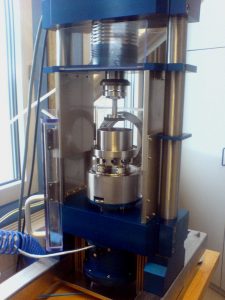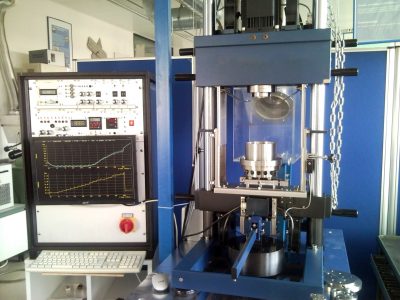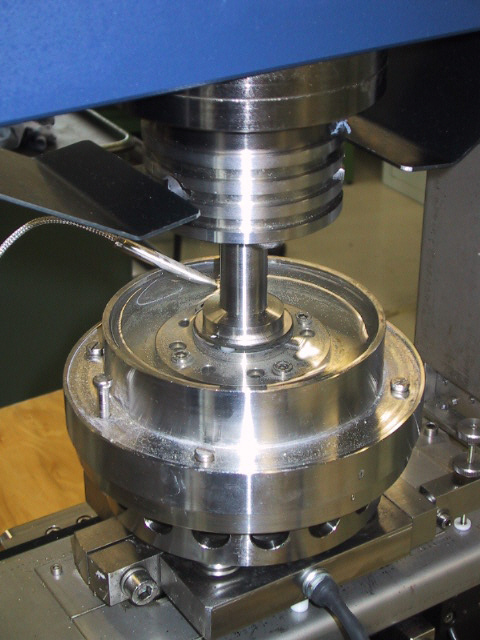Rotary tribometer (RT8001 and TRM 1001)



|
A rotary tribometer is used to investigate and simulate friction and wear processes under continuous or oscillating sliding stress and axial load. With the aid of suitable adapters, almost all test specimen geometries can be used on these universal tribometers. In addition, tests with original components, such as axial plain bearings, valves, pump running surfaces, etc., are also possible. |
|
The factors that are decisive for tribological behavior, such as friction partners, surface roughness, normal force, sliding speed, temperature, sliding distance, surface pressure, intermediate material and ambient medium can be varied and controlled within wide limits on these test rigs. All measurement data is stored on a PC and is then available for further processing. |
| TRM 1001: The normal force of up to 1 kN is usually applied to the TRM1001 by means of a pneumatic muscle and can be varied in the barrel. However, it is also possible to statically load the specimen with a lever system. The drive is provided by a highly dynamic servo motor. |
| RT 8001: The RT8001 rotary tribometer is an in-house development for higher normal forces up to 8 kN. The normal force is applied pneumatically on the RT8001. The drive is provided by a state-of-the-art servo motor. With the aid of a special torsion adapter, static friction processes can also be resolved with high precision. |
| Test bench parameters | TRM 1001 | RT 8001 | |
| Speed | 60 to 6000 1/min | 60 to 6000 1/min | |
| Load | 10 to 1,000 Newton | 100 to 8,000 Newton | |
| Temperature | -25 to 350 °C | -25 to 350 °C | |
| Sliding speed | approx. 0.01 to approx. 12 m/s | approx. 0.01 to approx. 40 m/s | |
| Movement types/forms | Glide (rotation, oscillation and combination) | Glide (rotation, oscillation) | |
| Friction conditions | Solid state, boundary and mixed friction, elastohydrodynamics | Solid state, boundary and mixed friction, elastohydrodynamics | |
| Contact geometry | Point, line and surface contact | Point, line and surface contact | |
| Ambient media | Room air, synth. Air, helium, nitrogen | Room air, synth. Air, helium, nitrogen | |
| Measured variables | Friction torque, oil temperature, specimen temperature, linear wear rate | Frictional torque, oil temperature, specimen temperature, linear wear rate, contact current |
|
The rotary tribometer is used to investigate and simulate friction and wear processes under continuous or oscillating sliding loads in solid, boundary and mixed friction as well as in elastohydrodynamics. With the aid of suitable adapters, almost all test specimen geometries can be used on these universal tribometers. In addition, tests with original components, such as thrust bearings, valves, etc., are also possible. |
|
|
|
The factors that are decisive for tribological behavior, such as friction partners, surface roughness, normal force, sliding speed, temperature, sliding distance, surface pressure, intermediate material and ambient medium can be varied and controlled within wide limits on these test rigs. All measurement data is stored on a PC and is then available for further processing. |
Norm and standard tests
- Characterization of the friction and wear behavior of materials and coatings
- Investigation of the response behavior and effectiveness of additives and lubricants in model and component tests
- Tests according to ISO/WD 7148: Plain bearings – Testing of the tribological behavior of bearing materials –
Part 1: Test of bearing materials; Part 2: Polymer-based bearing materials - ASTM G 99-05: Standard Test Method for Wear Testing with a Pin-on-Disk Apparatus
- Abrasive wear test following ASTM DG 132:
Standard Test Method for Pin Abrasion Testing - ASTM D 3702: Standard Test Method for Wear Rate and Coefficient of Friction of Materials in Self Lubricated Rubbing Contact Using a Thrust Washer Testing Machine
- Determination of breakaway torques of original components such as couplings; interference fits, etc.
Possible specimen geometries
